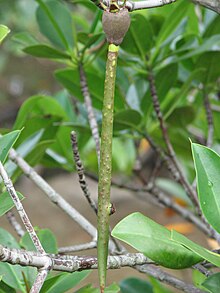
Rhizophora mucronata

| Rhizophora mucronata | |
|---|---|

| |
| With propagule | |
| Scientific classification | |
| Kingdom: | Plantae |
| Clade: | Tracheophytes |
| Clade: | Angiosperms |
| Clade: | Eudicots |
| Clade: | Rosids |
| Order: | Malpighiales |
| Family: | Rhizophoraceae |
| Genus: | Rhizophora |
| Species: | R. mucronata
|
| Binomial name | |
| Rhizophora mucronata | |
| Synonyms[2] | |
| |
Rhizophora mucronata (loop-root mangrove, red mangrove or Asiatic mangrove)[3][4] is a species of mangrove found on coasts and river banks in East Africa and the Indo-Pacific region.

Description


Rhizophora mucronata is a small to medium size evergreen tree growing to a height of about 20 to 25 metres (66 to 82 ft) on the banks of rivers. On the fringes of the sea 10 or 15 metres (33 or 49 ft) is a more typical height. The tallest trees are closest to the water and shorter trees are further inland. The tree has a large number of aerial stilt roots buttressing the trunk. The leaves are elliptical and usually about 12 centimetres (4.7 in) long and 6 centimetres (2.4 in) wide. They have elongated tips but these often break off. There are corky warts on the pale undersides of the leaves. The flowers develop in axillary clusters on the twigs. Each has a hard cream-coloured calyx with four sepals and four white, hairy petals. The seeds are viviparous and start to develop whilst still attached to the tree.[5] The root begins to elongate and may reach a length of a metre (yard) or more. The propagule then becomes detached from the branch when sufficiently well developed to root in the mud below.[6]

Distribution and habitat

Rhizophora mucronata is found in the Indo-Pacific region on the banks of rivers and on the edge of the sea. It is the only mangrove species to be found in East Africa.[5] R. mucronata is native to Africa (in southeastern Egypt; eastern Ethiopia; eastern Kenya; Madagascar; Mauritius; Mozambique; the Seychelles; Somalia; eastern side of South Africa down to Nahoon the southernmost mangrove forest in Africa; southeastern Sudan; and eastern Tanzania); Asia (in Burma; Cambodia; India; Pakistan; Iran; Indonesia; the Ryukyu Islands of Japan; Malaysia; Papua New Guinea; the Philippines; Sri Lanka; Taiwan; Thailand; and Vietnam) the South Pacific (in the Solomon Islands; and Vanuatu) and Australia (in northern Northern Territory; and northern Queensland).[3]

The natural habitat of Rhizophora mucronata is estuaries, tidal creeks and flat coastal areas subject to daily tidal flooding. It seems to be more tolerant of inundation than other mangrove species and often forms an evergreen fringe to mangrove areas. It sometimes occurs as a pure stand or may grow with Rhizophora apiculata.[6] The red mangrove is a protected tree in South Africa.[7]

Ecology
Rhizophora mucronata regenerates easily from seed but the seedlings are often damaged by crabs.[4] The leaves are also eaten by crabs [5] and form part of the diet of the crab-eating macaque (Macaca irus). The tree is attacked by the beetle Poecilus fallax.[4] In the Mangalavanam Bird Sanctuary near Cochin, India, it grows in association with the mangrove Avicennia officinalis, the golden leather fern (Acrostichum aureum) and the sea holly (Acanthus ilicifolius).[8]

Uses
Rhizophora mucronata has multiple uses. It is used to help prevent coastal erosion and in restoration of mangrove habitats.[1] The timber is used for firewood and in the construction of buildings, as poles and pilings, and in making fish traps. The fruits can be cooked and eaten or the juice extracted to make wine, and the young shoots can be consumed as a vegetable. The bark is used in tanning and a dye can be extracted from both bark and leaves. Various parts of the plant are used in folk medicine.[4]

References
- ^ a b Duke, N.; Kathiresan, K.; Salmo III, S.G.; Fernando, E.S.; Peras, J.R.; Sukardjo, S.; Miyagi, T. (2010). "Rhizophora mucronata". IUCN Red List of Threatened Species. 2010: e.T178825A7618520. doi:10.2305/IUCN.UK.2010-2.RLTS.T178825A7618520.en. Retrieved 19 November 2021.
- ^ a b "Rhizophora mucronata". Tropicos. Missouri Botanical Gardens. Retrieved 2017-02-05 – via The Plant List. Note that this website has been superseded by World Flora Online
- ^ a b "Rhizophora mucronata". Germplasm Resources Information Network. Agricultural Research Service, United States Department of Agriculture. Retrieved 2012-10-07.
- ^ a b c d Duke, James A. (1983). "Rhizophora mucronata Lam". Handbook of Energy Crops. Retrieved 2012-10-08.
- ^ a b c Gillikin, David; Verheyden, Anouk (2005). "Rhizophora mucronata Lamk. 1804". A field guide to Kenyan mangroves. Retrieved 2012-10-07.
- ^ a b "Rhizophora mucronata". AgroForestryTree Database. World Agroforestry Centre. Retrieved 2012-10-07.
- ^ "Protected Trees" (PDF). Department of Water Affairs and Forestry, Republic of South Africa. 15 June 2013. Archived from the original (PDF) on 5 July 2010.
- ^ Wildlife Holidays India. "Mangalavanam Bird Sanctuary". Retrieved 2012-10-08.
External links
- "Rhizophora mucronata Lam". Atlas of Living Australia.
- "Rhizophora mucronata Poir". Atlas of Living Australia.
- IUCN Red List least concern species
- Rhizophora
- Trees of Australia
- Flora of the Northern Territory
- Flora of Queensland
- Flora of East Tropical Africa
- Flora of Egypt
- Trees of the Indian subcontinent
- Trees of Indo-China
- Trees of Japan
- Flora of the Ryukyu Islands
- Flora of Madagascar
- Trees of Malesia
- Flora of Mauritius
- Flora of Mozambique
- Flora of Northeast Tropical Africa
- Natural history of Balochistan, Pakistan
- Trees of Papuasia
- Trees of Seychelles
- Protected trees of South Africa
- Trees of Taiwan
- Flora of Tanzania
- Trees of Vanuatu
- Central Indo-Pacific flora
- Western Indo-Pacific flora
See what we do next...
OR
By submitting your email or phone number, you're giving mschf permission to send you email and/or recurring marketing texts. Data rates may apply. Text stop to cancel, help for help.
Success: You're subscribed now !

